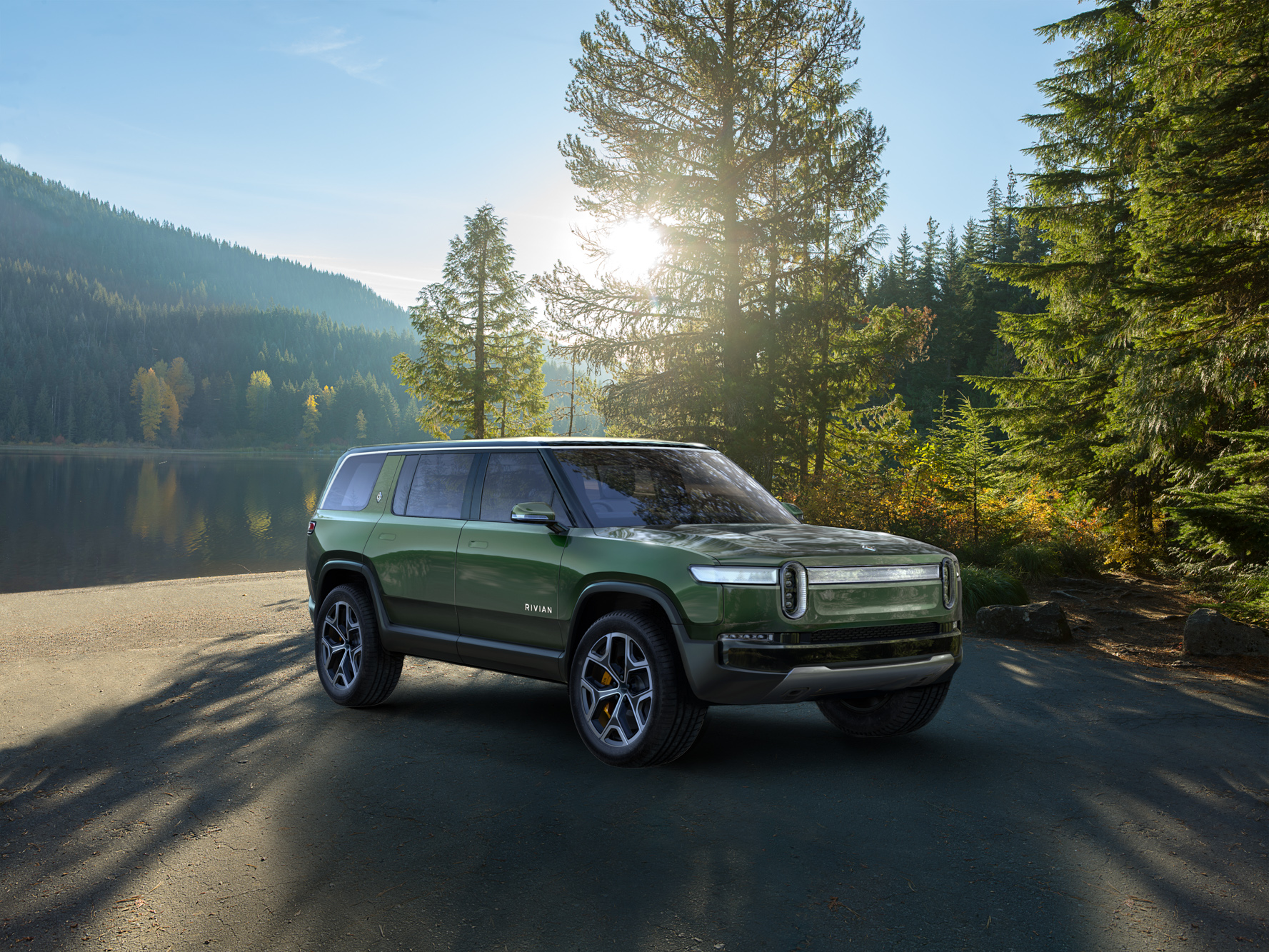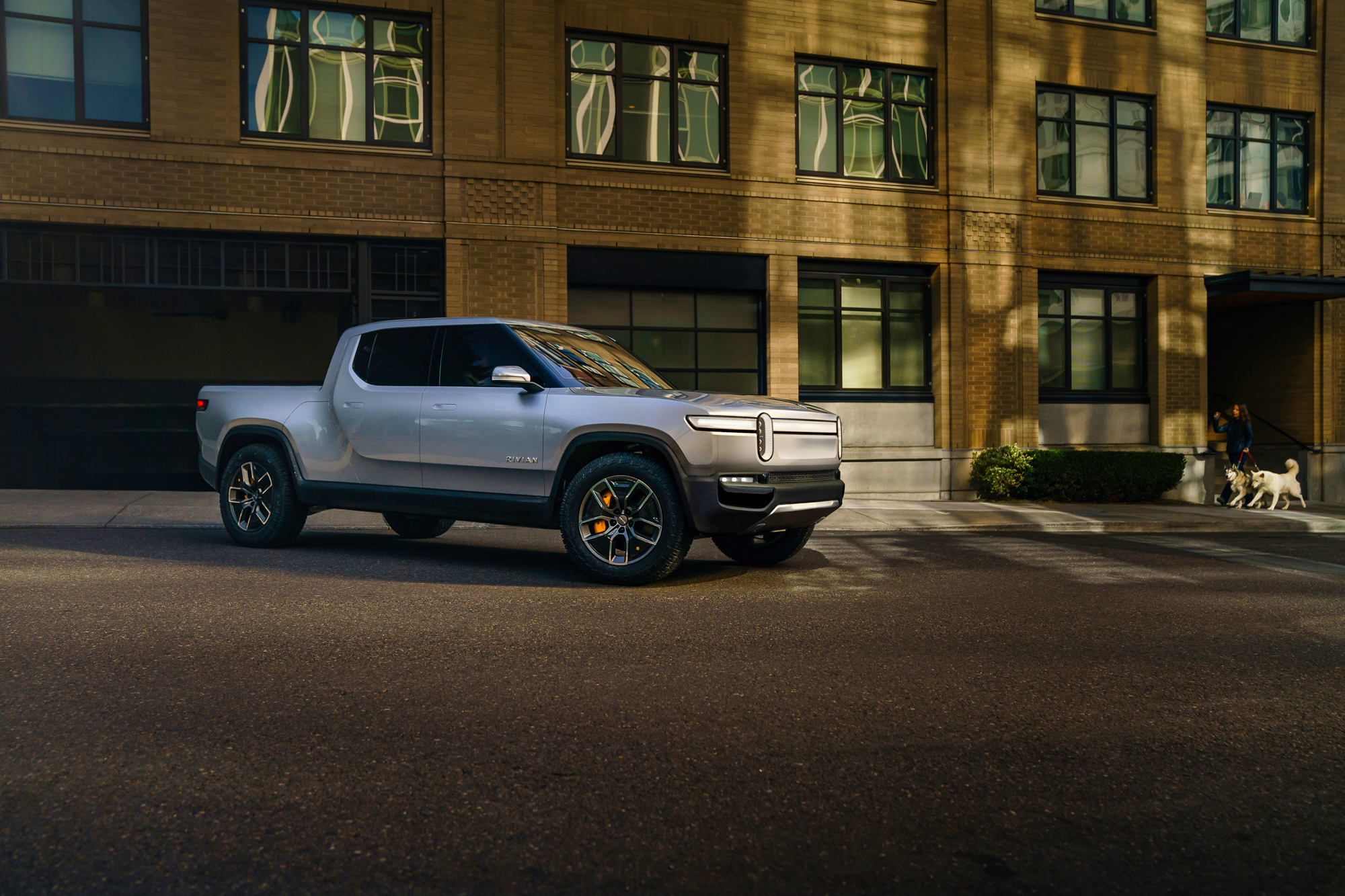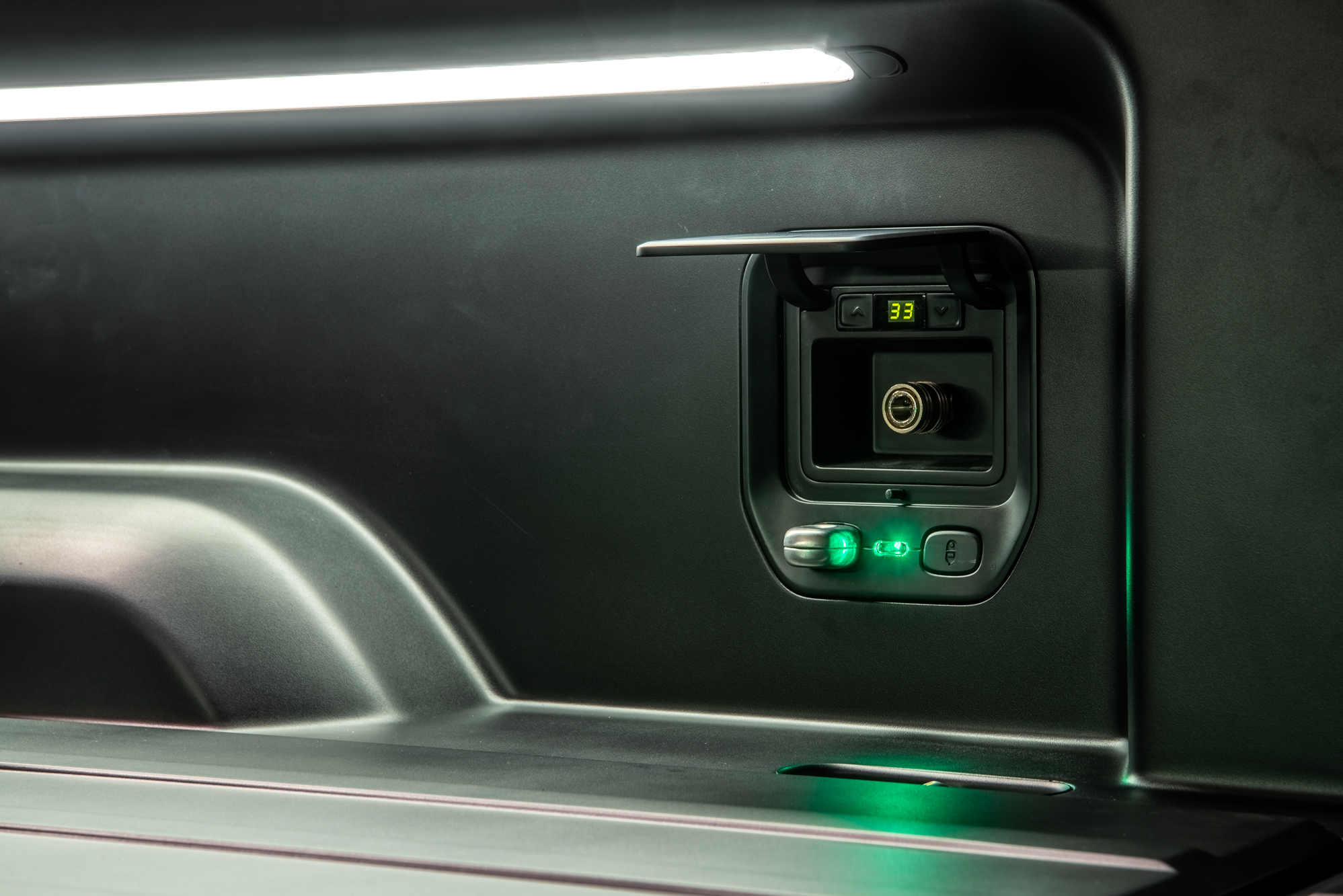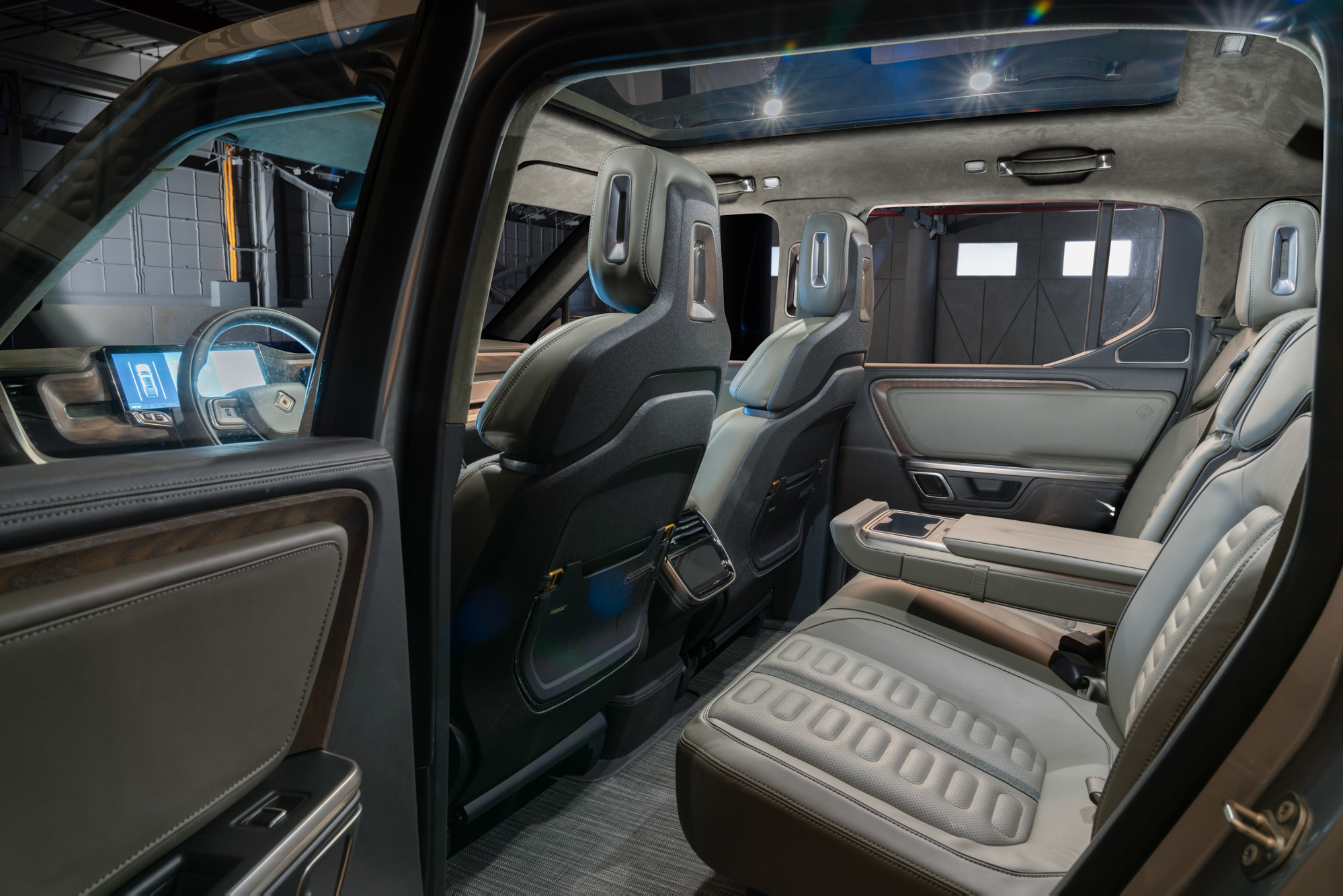It seems like ages ago that electric vehicles were just some crazy idea only relevant in the far future. They were novelties, toys for the super rich or environmentalists with very small commutes, yet here we are with companies like Tesla bringing them into the mainstream. The once quirky and difficult to use cars are now sleek, sexy, and easy to drive on a daily basis, yet for many of us they still have one major problem: they’re not really designed for adventures. If you want to carry a dirt bike, tackle some forest roads to reach a trail, or cruise through some soft-sand to go beach camping there just isn’t a legitimate electric option out there. Or, at least there wasn’t, until Rivian unveiled their R1 platforms, and quite frankly blew our minds.

Now I know that many of you are going to only half read this article while searching for the range and capability of these trucks in order to see if they’re really “adventure vehicles,” so let’s just start with the specifications.
R1T
- 400-mile range
- Curb weight, 5,886 pounds
- 750 horsepower
- 826 pound-feet of torque
- 0-60 in 3.2 seconds
- Wading depth of 1 meter
- Quad-motor AWD with independent motor controls
- Double wishbone suspension in the front and a multi-link suspension in the rear
- Dynamic roll control, adaptive dampers, and ride-height adjustable air-suspension
- 1,763-pound payload
- 11,000-pound tow capacity

R1S
- 410-mile range
- Curb weight, 5,842 pounds
- 826 horsepower
- 826 pound-feet of torque
- 0-60 in 3.2 seconds
- Wading depth of 1 meter
- Quad-motor AWD with independent motor controls
- Double wishbone suspension in the front and a multi-link suspension in the rear
- Dynamic roll control, adaptive dampers, and ride-height adjustable air-suspension
- 1,807-pound payload
- 7,716-pound tow capacity
The truck variant, dubbed the R1T, was the first to be revealed. It is fully electric and can carry five passengers for up to a 400-mile-total range, while the R1S (SUV) will carry seven passengers and has a maximum range of 410 miles! That’s some serious distance for trips, and puts actual off-road travel on the radar for many parts of the country with existing charging stations. But it’s not just about range, these trucks have some real technology behind them for tackling tough terrain as well.
Take the “AWD” system for example. It uses four independent electric motors to power the wheels, which means that in low traction scenarios it can turn each wheel independently with the precise amount of torque needed to move the truck. Think of it like a better version of lockers, where instead of forcing the wheels to turn at one rate you can take it one step further by putting the power only where it needs to go.
Not that you need to be stingy with it, as the motors produce 750 horsepower and 826 pound feet of torque. That will help either Rivian rip your face off in a 3.2 second 0-60, or 0-100 in less than 7 seconds. For reference, that 0-60 is just shy of the Ferrari 488’s time of 3 seconds flat.




While we don’t know the full details of the suspension, we can tell you it’s a double wishbone setup in the front with a multi-link in the rear. It will also feature adjustable air-ride for control of height and comfort needs on and off road, along with dynamic roll control and adaptive dampers for changing terrains. Total ground clearance on the “off-road” R1T is an impressive 14.7,” with approach, breakover, and departure coming in at 34, 26, and 30 degrees respectively. The SUV will boast just 5 millimeters more ground clearance, but with a 121-inch wheel base instead of the truck’s 135 inches, it improves the breakover by 3 degrees to a total of 29 degrees.



 The R1T has more lockable storage than any other truck currently produced, so you won’t have any trouble filling the vehicle’s nearly 1,800-pound payload capacity. You’ll get more than 350 liters of space in the lockable gear tunnel near the front of the bed, which is perfect for snowboards, camp chairs, Maxtrax, fishing rods, and other long skinny equipment. An additional 330 liters of storage is located in the trunk under the hood, a big advantage over petrol-powered competition. The bed also includes a watertight integrated tonneau cover and an under-bed 200-liter storage space which can be used to accomodate a full-size spare. The SUV variant will pack an equally large front trunk, plus the vehicle’s entire interior and a rear trunk of 180 liters.
The R1T has more lockable storage than any other truck currently produced, so you won’t have any trouble filling the vehicle’s nearly 1,800-pound payload capacity. You’ll get more than 350 liters of space in the lockable gear tunnel near the front of the bed, which is perfect for snowboards, camp chairs, Maxtrax, fishing rods, and other long skinny equipment. An additional 330 liters of storage is located in the trunk under the hood, a big advantage over petrol-powered competition. The bed also includes a watertight integrated tonneau cover and an under-bed 200-liter storage space which can be used to accomodate a full-size spare. The SUV variant will pack an equally large front trunk, plus the vehicle’s entire interior and a rear trunk of 180 liters.

Other fun features include three 110v outlets and an integrated air compressor plus locking cables to secure bike frames or other equipment to the truck bed. There is also a built-in security camera that can record anyone attempting to tamper with your gear—a nice touch for a vehicle that is going to clearly draw attention.




One of the other really nice additions is the Rivian rack system, which utilizes telescoping racks with easy-to-use mounts that quickly attach to the roof of either the R1T or R1S, as well as the bed rails and bed floor of the R1T. They’re designed to accomodate roof tents, existing luggage boxes, and all sorts of bike and ski racks, so you won’t have to leave any of your current adventure gear behind.




From here, things start to get really crazy, and maybe just a bit sci-fi. Both the R1T and R1S will include self-driving technology, and we’re not talking lane change alerts here. By using multiple modalities including camera, lidar, radar, ultrasonic, and high precision GPS coupled with high definition maps, both these vehicles provide a “hands-off wheel and eye-off road” level of autonomy on the highway. It can literally drive itself. Not that you’d want it to of course, because based on the videos posted near the end of this article, it looks like way too much fun to drive yourself.

 Both trucks will be made right here in the United States, and pricing is set to start at just $61,500 for the R1T and $65,000 for the R1S after federal tax credits. That won’t buy you the 3.2 second 180 kWh battery, but with an entry price that is actually in the realm of affordability we won’t complain. Deliveries begin in late 2020, and Rivian states that the fully-equipped vehicles with highest performance battery packs will be produced first.
Both trucks will be made right here in the United States, and pricing is set to start at just $61,500 for the R1T and $65,000 for the R1S after federal tax credits. That won’t buy you the 3.2 second 180 kWh battery, but with an entry price that is actually in the realm of affordability we won’t complain. Deliveries begin in late 2020, and Rivian states that the fully-equipped vehicles with highest performance battery packs will be produced first.

Although we haven’t seen one of these trucks in person, we couldn’t be more excited for their introduction. A 400-mile range and 14 inches of ground clearance is a massive step toward electric vehicles being capable of true backcountry travel. In fact, if enough charging stations or auxiliary fuel cells (think electric jerry cans) are developed, the Rivian would be more than just a step, but the first real option for off-road enthusiasts, and that is one heck of a breakthrough.
To learn more about the Rivian, check out the full spec sheet below, or visit their site at the provided link, but first, watch their “clean escape long version” video here. It’s sure to get you pumped about this truck.
Rivian “Clean escape long version” video





11 Comments
JJ
November 28th, 2018 at 7:10 amThat is great. I really glad you guys covered. I really hope it is embraced not just by outdoor enthusiasts but by all. It’s long overdue.
3jarrells
December 2nd, 2018 at 10:42 amMy two worlds have collided!
Been watching Rivian for years now, they have been quiet for sometime. They came to my attention when they bought the old Mitsubishi plant in Normal Illinois. Anyway, I’ve been commuting in an EV for several years now and finally got my Model 3 last March. It is phenomenal, and we can travel wherever we want in it (paved of course), we have even camped a few nights in Nation Parks with it. Frankly it makes my 4Runner feel like an absolute dinosaur. This Rivian checks a lot of boxes, EV torque is AMAZING, mountain passes in the Tesla are hardly noticeable.
Chris Cordes
December 20th, 2018 at 10:55 amI’ve never been a big ev person, but we can’t deny where things are heading these days, and the Rivian checks a lot of boxes for me as well. If they had fuel cells that could extend range to compensate for lack of charge stations in remote regions, I would certainly buy one.
anti
December 30th, 2018 at 5:27 pmthis is completely silly question but…
can’t it be charged from solar panels and/or power cells???
generators of ALL types???
wind turbine??? a la sailing…
are they not utilizing charging via brakes???
hmmm…
3jarrells
January 6th, 2019 at 12:10 pmChris, I think the likelihood of finding a 110V outlet in the wild is much greater than a H fuel station. There are H cars out now but they are all in CA, stateside anyway, where there are a couple fueling stations.
This fellow found his way, in what is now a quite dated VW conversion https://plugmeinproject.com
The frustrating part is that legacy manufacturers could easily build strong series hybrids, like the Volt and i3, with off the shelf parts. These systems are electric with a gas powered generator that runs at an optimum rpm. Not the weak stuff found in the current Ram. These could be upscaled easily for trucks, imagine campers with 50kw house batteries! Here is a company building systems for heavy trucks, lead by a Tesla co-founder. https://www.wrightspeed.com
Eric
December 3rd, 2018 at 11:54 amLooks amazing. I feel you could toss a decent generator and gas in the bed and “fuel” up a bit when you stop.
William
December 4th, 2018 at 4:19 am“… pricing is set to start at just $61,500.”
This is the same guy who claimed that placing an NMO antenna mount in the center of the roof was “far from ideal” and recommended the $330 brake light NMO mount.
I think we just figured out which editorial staff member has been bought and paid for by advertisers.
Chris Cordes
December 20th, 2018 at 10:54 amA magnetic antenna mount is NOT ideal stuck on your roof, especially when the truck is aluminum. And yeah, $61,500 is more than I can afford, but it’s common place for vehicles from Tesla or other luxury brands which Rivian clearly is. I do appreciate your willingness to read the article objectively, however we take advertorial VERY seriously here, and carry a zero tolerance policy. Neither Rivian nor the company who made that bracket are advertisers, and I have been yelled at in the past by an advertiser for giving their products a bad review, so please think twice before throwing accusations at people you’ve never met, especially just because you feel a product is too expensive. If you’d like to actually talk about this, you can contact our office and I’ll be happy to have a conversation with you. Or we can simply meet up and chat over a beer.
JD
December 25th, 2018 at 12:32 pmI’m truly intrigued. Could be my meet truck. The pricing is well within the range of current new trucks with similar capabilities.
One question I have is how does towing and hauling effect the range? 400 miles works for me, but if that’s cut in half while towing, that could be an issue especially if you have to coordinate finding a place to re-charge.
mpinco
January 3rd, 2019 at 10:14 amPaper specs are always dressed up by marketing. Example – towing capacity rated at 5000 kg/11,000
lbs. What is the range towing 5000lbs (typical TT or loaded trailer) at avg speed of 60mph?
Livid Lighting
February 22nd, 2019 at 12:42 amIndeed that Rivian Vehicles belong to Adventure Vehicles. It looks really awesome and powerful. Plus using LED headlights it would be a big help with night visibility, also it really saves much power. All in all, I’m so amazed by Rivian Electric Adventure Vehicle. Cheers! Great article.